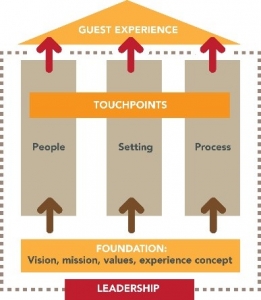In the previous blog, I wrote about my leadership style and how I use this at Innovation Square. I concluded, that it could be interesting to explore new leadership styles and make use of parts of it at Innovation Square. That is why I want to focus more on structuring the process by having a vision in mind and having a planning with potential successors. Furthermore, I realised that I have to involve the inhabitants of Innovation Square more in the decision-making process. The type of leadership is connected to the structure of an organisation. That is why this blog will be about the importance of leadership and structure in projects like Innovation Square.
Happenings during the project
Innovation Square wants the inhabitants to act as a community. This is a complex challenge because there are many different perspectives, languages, needs and demands involved. Furthermore, this is a process which means that we should have one solution in mind on forehand. Maybe a community is not the thing that is needed. What we do know, is that Innovation Square is a living system and developing this living system is tough. The biggest complexity right now is activating the inhabitants to contribute. In previous blogs, this complexity came by several times. Inhabitants have to feel ownership, there needs to be an added value, we cannot force them to contribute, they have to take responsibility and most importantly it is their living system so what is it what they want?
I tried to deal with this complexity, by focussing on their needs and demands. I dropped small interventions and during these moments, they got the opportunity to tell me what it is what they needed. I also asked them to think about things they can bring and provide, I asked their help and told them that they better know what to do because it is their living system. At the beginning of this process, I build relationships and search for a shared emotional connection. I listened to them and tried to empower their thoughts by giving them attention and helping them to execute. I believe this resulted in inhabitants knowing if they want to be part of the place or not. Right now, there is a natural selection, inhabitants leave and come. I noticed that the inhabitants who did not participate leave and that the ones who do participate, become more important and start taking responsibility and feel ownership.
Professional view
In previous blogs, I wrote about organisational structures, the system world and the lifeworld. I used Society 3.0, bureaucracy, adhocracy, bottom-up, top-down and organisations as machines vs organisations as conversations to come to a better understanding of structures. In our society, we are well known with all kinds of organisations. There are organisations with a bureaucratic structure, organisations and environments with less hierarchy, rules and restrictions and organisations that are organised somewhere in between. Comparing this information with the challenge at Innovation Square, I believe this place needs a structure ‘somewhere in between’ a structure that consists of the system world and lifeworld elements. Leading the place top-down will not work because it is a living system with many perspectives and complexities. On the other hand, not having any structure, rules and restrictions will not be beneficial for the place either. We already found out that as if we do nothing, nothing happens. Apparently, they need some structure and guidance in becoming a ‘self-steering community.’ Right now there is not enough ownership and urgency by the inhabitants to be self-steering. As you can read in my blog ‘choosing the right structure’, it does not work to impose an environment that needs to be self-steering, if there is no need for it. If participants do not see the added value of it, or if they do not feel the urgency to act in an environment like this, nothing will happen.
Guest Experience Model

This been said, we can conclude that the process of taking responsibility and feeling ownership needs to develop. But when doing a step back, it needs to be clear in what participants have to take responsibility and ownership. Not knowing what kind of structure to use is one challenge but at Innovation Square there is a bigger issue. It may not be the structure that causes inhabitants who do not want to participate. In my opinion, the foundation underneath this structure is missing. The Guest Experience Model by Van Wijngaarden (2006) helps to explain the importance of having a foundation. This model explains how to influence guest experience. This starts with creating a foundation based on a vision, mission, values and experience concept. This foundation becomes concrete and gets meaning via the three pillars people, setting and process. It is coming back every time and is always the same. The foundation needs to be clear and strong enough to carry the three pillars. If this is not the case, the building will ‘collapse’ and stops existing.
I compared this model with Innovation Square because in the end, they want to express their right for existing, like a festival wants to express itself as good as possible to guarantee the right guest experience. You can see the inhabitants as the people, the physical place as the setting and the system of BUas as the process. The leadership part of the model represents team Innovation Square and right now they struggle with the thee pillars because the foundation is not clear. There is a need for clarification to continue the process of building a living system and expressing its right for existing.
It is interesting to find out how this foundation can be made. As written above a different type of leadership can be used. Lead the inhabitants so that this foundation can be made by involving them in the decision-making process. it is their place, they have to feel ownership and take responsibility. I believe that constructing the foundation with them, based on their needs, demands and perspectives, results in a stronger foundation and long-lasting results. While creating this foundation, I create more structure, find a vision and search for potential successors by making use of relationships and social-emotional connections.
Transformation

As a conclusion of all information written above, Innovation Square has to transform. The place has to do a step back. Looking at the Lifecycle of Organisations model by Coenen (2010), an organisation falls from a balance, into a crisis situation (like Innovation Square experiences right now because of Corona). They want to have control as soon as possible to regain balance again. Transformation is needed to find control. According to Coenen (2010), this is possible if an organisation values, appreciates and understands their right to exist, they have to focus on reflection, they have to take time for creativity, they need to take care of their employees and it is time to lose control and change. Let go of the structure, rules and restrictions to do what feels good and what is needed. Focus on the living systems instead of systematic patterns. This sounds all very easy but unfortunately, this is not the case at all. Transformation is difficult and I will write more about this in my upcoming blog.





